Hi all! For my post, I made a video that captured a day in my life here in Bogotá, view it here!
Archive for the ‘Colombia (Loewenstern)’ Category
[VLOG] Day in the life of a Rice Student in Bogotá
Monday, July 17th, 2023Summer 2023 in Medellin, Colombia
Monday, June 26th, 2023I’m currently on my 5th week in Medellín, and it’s been quite an amazing experience so far! When I first arrived here, Medellin was just another city, but after a few weeks of learning and exploration, I’ve realized that this is a very special place with a fascinating history.
El Poblado
During my first week, I started off by visiting a castle and gardens in the luxurious El Poblado district, known as the commercial center of the city. It was once the house of the physician José Tobón Uribe until 1943 when industrialist Diego Echavarría Misas bought the house for his family. The inside of the castle contained beautiful antiques, paintings, and sculptures and there were panoramic views of the city from the windows. After my visit to the castle, I walked down a hill to the main square and explored the neighborhood. El Poblado was all very manicured—leafy boulevards, shiny malls, lavishly-decorated cafes and hotels. Though, I was told by locals that this did not represent the “real” Medellin—at least, not the city that the majority of the residents lived in.


Comuna 13
I began to venture more outside of the wealthiest districts of the city. For instance, a couple of my fellow Rice students and I visited Comuna 13, a historically low-income, informal settlement that was originally occupied by rural migrants who had been displaced from their homes. The neighborhood’s residents were often caught in the crossfire between gangs, drug trafficking organizations, guerillas, and paramilitary groups. In the last 20 years, a government-sponsored re-development project and the construction of outdoor escalators has transformed the neighborhood into a safe tourist attraction with very little violence. Today, thousands of people visit Comuna 13 each day to view its colorful graffiti art, which was created by local artists as symbols of hope and resilience in the community. However, one could say that Comuna 13 is no longer the “real” Medellin either—as it is now overrun by souvenir shops and foreign visitors. There is also an argument to be made that the increasing tourism makes the residents of the neighborhood a spectacle—though it has also provided a large boon to the economy, promoting local businesses and the creation of jobs.
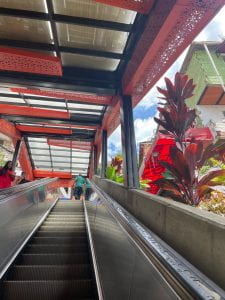
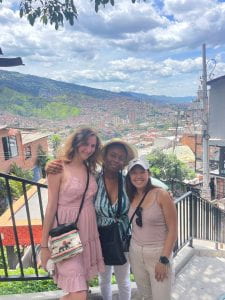


MetroCable
Another memorable experience I’ve had so far is riding the Medellin Metro Cable, a public transportation service and gondola lift system. It was designed to connect low-income communities on the city’s steep hills to the Valley of Aburra, which includes the city center. Before the invention of the Metro Cable, some hillside residents in communities such as Santo Domingo spent nearly 3 hours commuting to work because of the lack of a convenient bus system. When the service began its operations in 2004, the Metro Cable improved the mobility of residents of mountainside communities and massively shortened their commutes to work. Many studies attribute the gondolas to reductions in crime and an increase in economic prosperity in areas near the MetroCable.
There are also spectacular views from the gondolas. From the last stop at Santo Domingo, I was able to see large parts of the city and the Andes mountains in the distance. I also enjoyed being able to look down and see houses, streets, basketball courts, food vendors, and graffiti. It was like getting a little slice of life from a bird’s eye view.
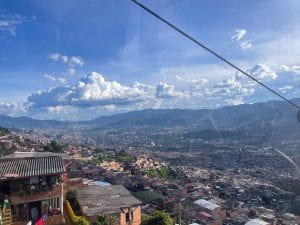
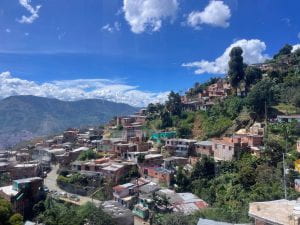
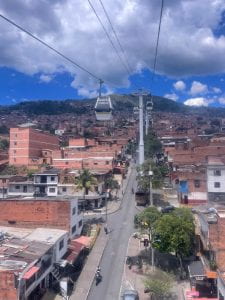
Bike Tour
A couple weeks ago, I decided to sign up for a 4-hour bike tour. It was a chaotic and strenuous ride—but, ultimately, it was incredibly rewarding. First, we biked up Cerro Nutibara, a steep hill in the middle of the city, that left me exhausted and out of breath. Luckily, there was a refreshing coconut drink once we got to the top.
One of my favorite parts of the tour was biking through Downtown, which was a surreal experience, since it was packed to the brim with people. Trying to bike through large crowds, motorcycles, cars, and street vendors was definitely a challenge, though it was a great way to experience the vibrance of the city center. We stopped right outside the main train station for a Colombian snack, and I got to eat this delicious arepa de chocolo, which is basically a fried corn tortilla with cheese on top.


Throughout the tour, I learned a lot about Medellin’s status as one of the world’s most innovative cities that has set many milestones for sustainable design and equitable urban planning in the last 25 years. Recently, miles of cycling lanes were added to streets across the city, including in both low-income and high-income areas. Medellin has also introduced a new initiative called ciclovia, in which they close one of the major roads, Avenida Poblado, on Sundays and open the street up entirely to pedestrians, bikers, and even roller skaters.
Conclusion
It was interesting to see how perhaps Houston had much to learn from Medellin in terms of public transportation, infrastructure, and sustainable design. Medellin certainly still has a long way to go; in my experience, the bike infrastructure was not perfect—sometimes I was on the road with cars and a few times I had to swerve to avoid potholes—but I would say that it was still better than my biking experience in Houston.
Furthermore, while Medellin still has a significant amount of inequality, it was truly fascinating to see the transformation that the city has undergone only in the last couple decades. The MetroCable and the outdoor escalators, in particular, were some of the best examples of creative and equity-focused public transportation, and were both pretty incredible to witness in-person.
Halfway Done, Reflecting on my time here in Medellin, Colombia
Monday, June 26th, 2023As of writing this, I have just completed my fifth week here in Medellin, Colombia. This experience was transformative, as I have seen remarkable changes within myself. The city itself is vibrant and full of life, with a rich history and culture that I have been eager to explore through museums, events, and restaurants. Of course, some challenges come with living in any new place—language barriers, cultural differences, and navigating unfamiliar streets—that can be daunting at times. But overall, I feel incredibly grateful for this opportunity to immerse myself in a new culture and way of life.
Since this is the first time I have traveled outside the United States without family and the primary language is not English, these stressors caused some pre-travel jitters. For weeks leading up to my flight, I tried to appease my nerves by teaching myself as much about the country as possible before my trip. (This comes from my mother, as we both, or at least try to, overprepare for anything.) I researched everything about the country, the city, and the specific neighborhood that I would be living in for the summer through the internet, social media, and talking to family, friends, and other people who had visited Colombia before. I also listened to more media in Spanish in hopes of easing the transition from primarily speaking English to Spanish outside my house. The measures taken helped me, but they failed to prevent the cumulation of these anxieties and more.
One of the anxieties I struggled with was switching dominant languages. Coming from a monolingual household, I struggled with accepting that no one in my family could help me with this mandatory switch. However, I did my best to prepare for it myself. Despite this, I have experienced some challenges. Some of my speaking anxiety stemmed from my limited vocabulary and not-so-perfect grammar. The limited vocabulary could be fixed by speaking more and learning slang and colloquialisms. However, grammatical issues could only be fixed through practice in speech. At first, my speaking anxiety prevented me from speaking freely. However, I was pleasantly surprised by how understanding people were of my speech. When I could clearly communicate, I marked those times as a little win for myself. Of course, there were times that I accidentally mispronounced a word and/or said a similar-sounding word with a completely different meaning. However, even during those times, the person I was talking to was usually empathetic and spoke clearly so that I could understand.
Though having an empathetic listener is normally the case, this will not always be the case. There would be times when a stutter, hesitation, or even my accent hinted to another person that Spanish wasn’t my primary language. Because of this, the other person would automatically switch to English if they knew, or act annoyed and stop talking to me altogether. For example, during my third week here, I took the wrong bus. It traveled to the downtown area of the city, which is in the opposite direction from where my apartment is located. When I noticed this, I attempted to talk to the bus driver, mentioning my concern about my current location and if the bus would go to my apartment or at least return to the station I entered from. However, the driver started shouting. In the noisy environment, I was unable to completely comprehend what the driver was saying. After two minutes of trying to understand what he was saying, he went quiet and ignored me. (I was eventually informed by a lady on the bus that if I continued sitting on the bus, it would return me to my intended location.)
In either case, I would feel a mix of emotions. I would start to second-guess myself, feel self-conscious about my skills, and begin to clam up. However, soon after those events, I would have to continue forward and push these negative feelings behind me instead of wallowing. These good and bad speaking experiences serve as learning experiences, and I realized early on that I could not just take the good without the bad. To see true progression, I had to embrace my flaws and strengths simultaneously.
Learning that lesson liberated me from the feeling of trying to speak perfect Spanish. Free from that suffocating feeling, I could work to improve myself through everyday conversations with my co-workers and passersby. Through fully embracing this immersive experience, I have gained a more adventurous and confident stature. Now, if there are events I would like to go to, I would go, not allowing my prior anxieties to continue dictating my decisions. I want to take a stroll around the neighborhood. Why not? I want to go to the local theater to watch a new movie. Sure, who is stopping me? (Of course, I would have to consider safety precautions as a solo traveler in these situations.) Contrary to my previous sentiment, which would constantly impede my personal exploration, this new way of thinking allows me to truly enjoy my time here.
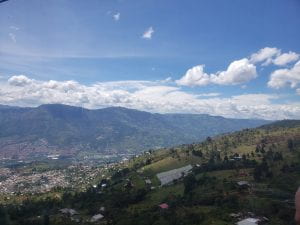
Cable Car Experience

Last Train in Medellin
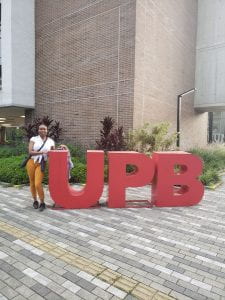
Visiting local universities: UPB
Now that I’m at the halfway point, reflecting on my progression since coming here has served as a great reminder of my personal and professional development. As I look forward to my future weeks here, I plan to keep an open mind and embrace every moment.

Meeting Dr. Cesar Uribe

